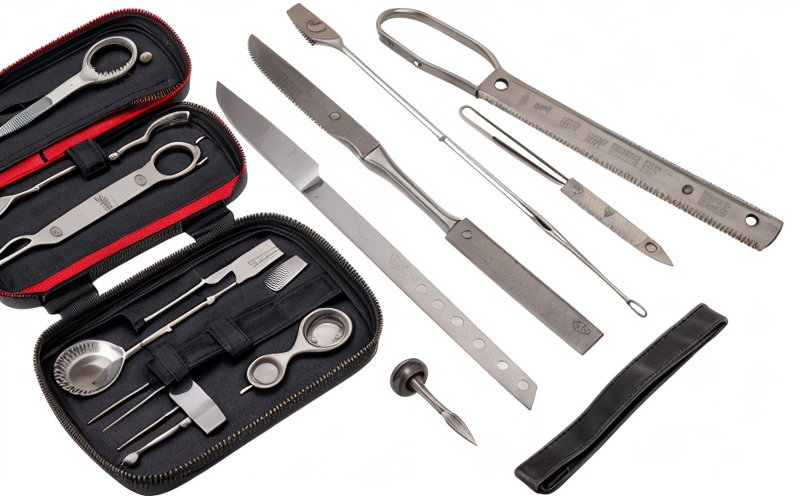ISO 17665 Steam Sterilization Resistance Testing
The ISO 17665 standard provides a set of requirements and methods to evaluate the resistance of surgical instruments to steam sterilization. This test is critical for ensuring that medical devices can withstand the harsh conditions of autoclaving without compromising their functionality or integrity. Compliance with this standard ensures that healthcare facilities receive products that meet stringent quality and safety standards, thereby protecting patient safety.
During steam sterilization, the instrument undergoes high-pressure steam at temperatures typically ranging between 120°C to 134°C for durations from 3 to 18 minutes. The goal is to eliminate all microorganisms present on or within the surgical instruments. However, some materials and designs may not tolerate these conditions well, leading to potential failures such as warping, cracking, or loss of functionality.
The ISO 17665 test involves subjecting the surgical instrument to multiple cycles of sterilization under controlled laboratory conditions. Specimens are prepared by cleaning them according to industry best practices and ensuring they represent realistic use scenarios. After each cycle, the instruments undergo thorough inspection for any signs of damage or degradation.
The primary outcome metric is the percentage reduction in performance capabilities after exposure to steam sterilization compared to pre-sterilization conditions. Acceptance criteria are typically defined within the standard itself, specifying permissible levels of change that still allow devices to function safely and effectively post-sterilization.
In addition to direct mechanical testing, additional analyses may be conducted depending on material composition or design complexity. These could include chemical analysis to assess compatibility with sterilization gases, thermal cycling tests to mimic real-world usage patterns, and microbiological assays to verify complete decontamination.
Understanding the nuances of this test is crucial for manufacturers aiming to bring compliant products to market quickly yet safely. It also helps regulatory bodies ensure compliance during audits or inspections.
The process begins with careful selection of appropriate samples reflective of actual product designs and intended end uses. Proper documentation throughout all stages ensures traceability and reproducibility, which are essential aspects in meeting regulatory requirements.
By adhering to ISO 17665 standards during development and manufacturing phases, companies can demonstrate their commitment to delivering high-quality medical devices that meet global expectations for safety and efficacy.
Why It Matters
The importance of ISO 17665 lies in its role as a key indicator of the robustness of surgical instruments against steam sterilization. Ensuring compliance helps protect patients from potential risks associated with improperly sterilized equipment, which can lead to infections or other adverse effects.
From the perspective of manufacturers and suppliers, demonstrating adherence to this standard adds significant value by showcasing expertise in meeting rigorous industry standards. This not only enhances brand reputation but also opens doors to international markets where stringent quality controls are enforced.
For healthcare providers, knowing that their instruments meet these stringent requirements provides peace of mind regarding patient safety. It ensures they have reliable tools available whenever needed, minimizing disruptions and ensuring continuity in providing quality care.
In summary, compliance with ISO 17665 is about more than just meeting regulatory demands; it's a commitment to excellence that translates into better outcomes for everyone involved—from manufacturers to healthcare professionals to patients themselves.
Applied Standards
The primary standard governing steam sterilization resistance testing for surgical instruments is ISO 17665-1:2019. This document specifies the general requirements and methods applicable to this type of evaluation. Additional relevant standards include:
- ISO 11135: Sterilization of health care products—Steam sterilization (autoclaving) and related techniques.
- EN ISO 17665-1: Compliance with ISO 17665 across European Union countries.
- ASTM E2394: Standard practice for conducting steam sterilization resistance testing on medical devices.
These standards provide comprehensive guidance on selecting appropriate test methods, preparing specimens correctly, and interpreting results accurately. They serve as benchmarks against which compliance can be measured.
Why Choose This Test
Selecting ISO 17665 steam sterilization resistance testing for surgical instruments offers several advantages:
- Regulatory Compliance: Ensures that products meet international standards, facilitating easier market access.
- Patient Safety: Verifies that devices remain safe and effective after exposure to autoclaving conditions.
- Innovation Support: Provides valuable insights into material performance under harsh sterilization environments, aiding R&D efforts.
- Risk Mitigation: Identifies potential issues early in the development process, reducing costly rework later on.
- Quality Assurance: Establishes consistent quality across batches by ensuring uniform testing procedures.
- Reputation Enhancement: Demonstrates a commitment to excellence and reliability among stakeholders.
The rigorous nature of this test underscores its significance in maintaining the highest standards of medical device integrity and performance. By incorporating it into their quality control programs, organizations can ensure they are delivering top-tier products that meet both current expectations and future challenges.





